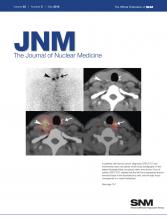TO THE EDITOR: The level of striatal dopamine transporter (DAT) availability in the human brain has been associated with polymorphisms in the gene encoding for DAT (SLC6A3) (1). We have shown that a specific allele combination for polymorphisms in the 5′ and 3′ ends of the gene affects DAT availability in a sample of young, healthy subjects; that is, an increased striatal DAT availability is associated with haplotype T-A-9R for the single-nucleotide polymorphisms (SNPs) rs2652511 and rs2937639 and the variable number of tandem repeat (2). Recently, a novel alternative splice variant was discovered in intron 3 of the DAT gene, designated E3b (3). It was demonstrated that alternative splicing of E3b can occur in postmortem human substantia nigra (3). It has not yet been demonstrated whether this novel splice variant is functional and is translated in vivo. We tested this hypothesis indirectly by investigating an association between 2 clusters of SNPs that flank the novel splice site in relation to striatal DAT availability in the previously described sample of young, healthy subjects (2). These SNPs delineate 2 common haplotypes that differentially affect E3b splicing (3). The alternative splicing incorporates multiple stop codons that cause early truncation of the DAT open reading frame and are expected to trigger nonsense-mediated decay of the messenger RNA. Thus, protein products incorporating the alternative splice variant would not be predicted, and an increase in E3b splicing should lead to a decrease in total DAT (SLC6A3) messenger RNA and DAT protein.
Briefly, the sample consists of 74 Caucasian young, healthy adults, for whom striatal DAT availability was determined with 123I-β-CIT (2β-carbomethoxy-3β-(4-iodophenyl)tropane) SPECT (2). Four SNPs that are associated with the novel splice variant (cluster 2: rs420422, rs462523, upstream of E3b; cluster 1: rs458609, rs457702, downstream of E3b) were genotyped for these subjects. The genotyping procedure was described earlier (3). Individual effects of these 4 SNPs and haplotype effects were analyzed with correction for age and sex using previously described methods (2). In addition, haplotypes including the previously genotyped SNPs rs2652511 and rs2937639 and variable number of tandem repeat were tested for associations. Finally, a 4-polymorphism haplotype (rs2937639–rs462523–rs458609–variable number of tandem repeat) that helps delineate 2 common haplotypes was analyzed.
The analyses did not show any significant associations between the 4 newly genotyped SNPs and striatal DAT availability. Neither did we find a modifying effect of the 4 SNPs in the haplotype analyses (Supplemental Table 1; available online at http://jnm.snmjournals.org). Thus, our hypothesis was not supported. We cannot exclude that a subtle effect of the splice variant can occur in a larger sample or using other indices of DAT expression. However, the hypothesized rapid decay of the alternatively spliced product means that it would be difficult to test the hypothesis directly by assays of the hypothetical protein product. The role of the splice variant in human pathology is still unclear. There were initial associations with the SNP clusters linked to the splice variant and schizophrenia, but these were not supported by subsequent genomewide association studies (3). Further studies on the splice variant are necessary to demonstrate whether it has a functional role. In addition, other common or rare polymorphisms in the DAT gene, which are not covered by the currently genotyped markers, may still be associated with striatal DAT availability.
In conclusion, we do not find a significant association between 4 novel SNPs and in vivo striatal DAT availability. We suggest future studies to assess whether the novel splice variant in the DAT gene has a functional role.
Footnotes
Published online Mar. 16, 2012.
- © 2012 by the Society of Nuclear Medicine, Inc.







